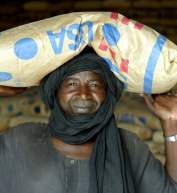- Agriculture and Food Security
- Democracy, Human Rights and Governance
- Economic Growth and Trade
- Education
- Environment and Global Climate Change
- Frontiers in Development
- Gender Equality and Women's Empowerment
- Global Health
- Science, Technology and Innovation
- Water and Sanitation
- Working in Crises and Conflict
Recovering From Crisis
More than 200 million people in 98 countries were affected by natural disasters in 2011.
Because crises and the temporary hardship they cause cannot always be prevented, USAID is always prepared to provide emergency aid to those in need worldwide. But we know that simply providing for the immediate needs without taking into account the mid- and long-term needs of crisis affected communities is neither efficient nor effective.
USAID’s emergency aid programs provide the immediate relief people need in the aftermath of a crisis, while also setting the stage for recovery and rehabilitation.
This could be something as simple as:
- Providing tools and seeds to allow farmers to restart former jobs
- Providing psychosocial care to traumatized disaster survivors
- Preparing affected people to get back on their feet
A key component of moving quickly from saving lives to post-disaster recovery is having our disaster response experts work closely with our development experts, who focus on making long-term, systemic improvements in more than 80 countries worldwide.
By coordinating urgent relief activities with sustainable, multi-year programs, USAID helps people not only get back to where they were before the disaster, but also move toward continued growth.
To fully or effectively meet beneficiary needs, USAID seeks unconventional and innovative ways to save lives or improve conditions after a disaster. For example:
- Post-earthquake Haiti, where urban populations were displaced on an unprecedented scale, necessitated new approaches to shelter and settlements programs that not only offered affected families a roof over their heads, but also enabled Port-au-Prince residents to salvage existing buildings and keep neighborhoods intact.
- In the heavily earthquake-damaged neighborhood of Ravine Pintade, USAID helped comprehensively rehabilitate the area using an integrated, community-based approach that is helping 620 households re-establish their pre-earthquake economic and social structures.
- In many African nations, USAID provided mobile cash transfers, allowing people to purchase needed food or items to restart small businesses using their cellphones.
Such programs take communities beyond the immediate aftermath of a disaster, alleviating suffering and reducing the social and economic impact of the crisis as they begin to recover.








Comment
Make a general inquiry or suggest an improvement.